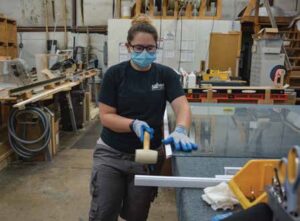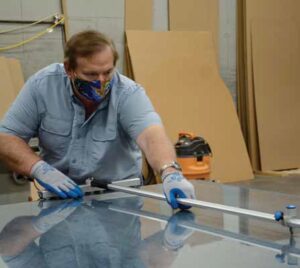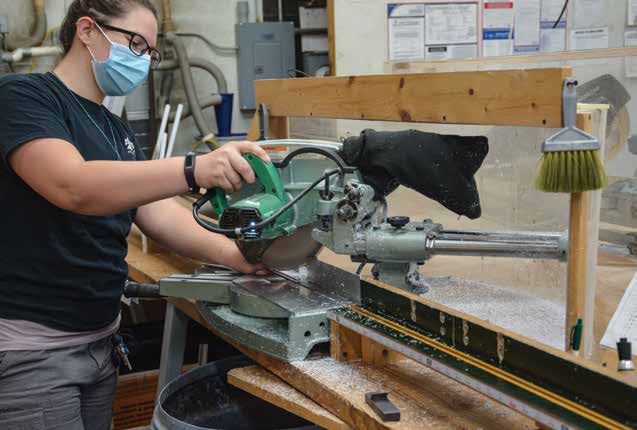For the last 25 years my wife and I have been restoring an historic home in Sherman. Our projects have run the entire spectrum of renovation from basement to attic over this time and we have performed the majority of this work with our own hands. We have, by necessity and interest, become on-the-job experts on a variety of construction topics. One of these areas has been bringing some semblance of energy efficiency to a structure originally built in 1843. Over time we modernized our home’s envelope with plywood sheathing, house-wrap and new cedar siding. We filled marginally insulated exterior walls with fiberglass insulation and hunted down remaining gaps and cracks from the sill beams to the soffits and filled them with spray foam. However, when it came to the original, single-pane, historic wood window sashes we struggled to find a solution. We saw these original windows with their wavy glass and delicate scale as essential to maintaining the character of the structure. We put great effort into restoring them one-by-one only to find that they remained drafty and extraordinarily inefficient. Condensation and ice that would accumulate on the inside of the windows on cold days would serve as both an indicator of this inefficiency as well as a major destructive force to the sashes themselves rapidly undoing our restoration work. Traditional storm windows placed on the exterior only seemed to help marginally with efficiency while trapping harmful moisture in the area between the sashes and the storm window. The traditional exterior storm window, in our opinion, also detracted from the aesthetic of the house’s appearance overall.
 We began research for an alternative and came across a unique solution – a storm window that is installed on the interior of a window opening. The manufacturing company is fittingly called Innerglass. Based in Simsbury, CT., Innerglass describes their product as “high quality, vinyl framed. Glass Interior Storm Windows that mount on the inside of the stops of the primary window, where they seal tightly, eliminating drafts, condensation, and noise problems.”. When I contacted Innerglass, I was very pleased to leam that I was dealing directly with the owners Kimber and David Degling. David and Kimber were exceedingly knowledgeable, enthusiastic, and helpful. Their Innerglass website was chock-full of a fantastic mix of successful project examples with photos, first person testimonials by happy customers, how-to installation videos, as well as a thorough explanation on why the interior of your home is a better place for a storm window than the exterior. To my personal delight there was also a plethora of wonky scientific information on insulation, acoustics, UW rays and such that David was more than willing to discuss at great depth and for as long as I liked. It wasn’t long before we had settled on trying out Innerglass’s interior storm panels. Kimber sent us a packet that contained cataloging sheets with instructions for us to provide accurate measurements of all 15 of the windows that we needed a storm panel for. Upon receiving the sheets back, David reached out to review them with us window by window, pointing out some things that seemed curiously crooked even for an old home. We identified some minor adjustments to two of the panel’s dimensions and signed the final order to proceed with manufacturing.
We began research for an alternative and came across a unique solution – a storm window that is installed on the interior of a window opening. The manufacturing company is fittingly called Innerglass. Based in Simsbury, CT., Innerglass describes their product as “high quality, vinyl framed. Glass Interior Storm Windows that mount on the inside of the stops of the primary window, where they seal tightly, eliminating drafts, condensation, and noise problems.”. When I contacted Innerglass, I was very pleased to leam that I was dealing directly with the owners Kimber and David Degling. David and Kimber were exceedingly knowledgeable, enthusiastic, and helpful. Their Innerglass website was chock-full of a fantastic mix of successful project examples with photos, first person testimonials by happy customers, how-to installation videos, as well as a thorough explanation on why the interior of your home is a better place for a storm window than the exterior. To my personal delight there was also a plethora of wonky scientific information on insulation, acoustics, UW rays and such that David was more than willing to discuss at great depth and for as long as I liked. It wasn’t long before we had settled on trying out Innerglass’s interior storm panels. Kimber sent us a packet that contained cataloging sheets with instructions for us to provide accurate measurements of all 15 of the windows that we needed a storm panel for. Upon receiving the sheets back, David reached out to review them with us window by window, pointing out some things that seemed curiously crooked even for an old home. We identified some minor adjustments to two of the panel’s dimensions and signed the final order to proceed with manufacturing.
 Approximately 6 weeks later our storm panels arrived at our home delivered by David and Kimber in person. Each panel had a subtle yet easy to find sticker with its location name originally designated on the measuring sheets. Innerglass is a product that is designed to be easily installed by even the most mechanically challenged of homeowners and it does not disappoint in that goal. (For context, I would say that if you can hang a set of blinds, you will have no issue tackling this install). For us, as well seasoned handy-folk, installation was a breeze. All 15 panels were in place inside of about five carefully paced hours of work. To say that our Innerglass storm panels have been transformational might sound hyperbolic but none-the- less is pure fact. Gone are the drafts on windy days. There is no more (zero) interior icing. Condensation is non-existent on all the windows with the exception of minor fogging in two of the most humid rooms and only on the coldest of days. Our humidity levels became stable and comfortable due to the fact that there are no uninsulated windows acting as “dehumidifiers”, incessantly sapping moisture from the air through the condensation process. During the summer, we no longer feel the searing heat of the sun beating through the windows, likely indicating that the Low E coating we opted for is doing its job. Our beautiful historic sashes are on unobstructed display from the outside of the house. The appearance of their wavy glass has seemingly been enhanced, when viewed from the inside through the Innerglass storm panels. (David had suggested this would be the case during one of our conversations when I voiced concern that the Innerglass panels would detract from the waviness and irregularity of the historic glass. I was skeptical – He was right). Perhaps the most monumental difference the panels made was one that was instantly noticeable. Like many historic homes, ours is located in close proximity to a busy street. Road noise is a significant factor especially in the front rooms closest to the traffic. Once we had installed the Innerglass panels I was floored by the drop in noise from outside. Having become accustomed to that noise for about 24 years at the time when we installed our Innerglass panels, I now felt like I was standing in someone else’s far quieter home.
Approximately 6 weeks later our storm panels arrived at our home delivered by David and Kimber in person. Each panel had a subtle yet easy to find sticker with its location name originally designated on the measuring sheets. Innerglass is a product that is designed to be easily installed by even the most mechanically challenged of homeowners and it does not disappoint in that goal. (For context, I would say that if you can hang a set of blinds, you will have no issue tackling this install). For us, as well seasoned handy-folk, installation was a breeze. All 15 panels were in place inside of about five carefully paced hours of work. To say that our Innerglass storm panels have been transformational might sound hyperbolic but none-the- less is pure fact. Gone are the drafts on windy days. There is no more (zero) interior icing. Condensation is non-existent on all the windows with the exception of minor fogging in two of the most humid rooms and only on the coldest of days. Our humidity levels became stable and comfortable due to the fact that there are no uninsulated windows acting as “dehumidifiers”, incessantly sapping moisture from the air through the condensation process. During the summer, we no longer feel the searing heat of the sun beating through the windows, likely indicating that the Low E coating we opted for is doing its job. Our beautiful historic sashes are on unobstructed display from the outside of the house. The appearance of their wavy glass has seemingly been enhanced, when viewed from the inside through the Innerglass storm panels. (David had suggested this would be the case during one of our conversations when I voiced concern that the Innerglass panels would detract from the waviness and irregularity of the historic glass. I was skeptical – He was right). Perhaps the most monumental difference the panels made was one that was instantly noticeable. Like many historic homes, ours is located in close proximity to a busy street. Road noise is a significant factor especially in the front rooms closest to the traffic. Once we had installed the Innerglass panels I was floored by the drop in noise from outside. Having become accustomed to that noise for about 24 years at the time when we installed our Innerglass panels, I now felt like I was standing in someone else’s far quieter home.
While our Innerglass panels have delivered beyond expectation in every category we hoped they would, there are some “cons” that also bear mentioning. They did take a little getting used to aesthetically from the inside. David had said anecdotally that most customers find they “sort of disappear” after a few days or so. I found that to be true but my wife, with a design background and a higher “visual bar” is likely not a total convert in this area. Very importantly, as these panels are installed on the inside of a window’s opening, they will impact the use of inset window treatments. This is something you may have to consider and be prepared to work around with your existing window treatments. Lastly, but most importantly, there is the actual dollarsand-cents of the Innerglass panels. Like many things associated with upgrading your house, they are not cheap.
They are, however, significantly less expensive than a replacement window and the associated labor. Innerglass panels will deliver return on investment from day one in the form of significant energy savings, noise reduction, reduced abuse on your interior contents from heat and Ultraviolet rays, and a longer lifespan on the window sash they are protecting. Additionally, we felt great about making this investment with a small, family-owned, local company that manufactures their product here in the USA. Overall, I would say that my only regret in the end is that we did not find Innerglass and utilize their wonderful product years earlier.
Joel Bruzinski
Sherman

